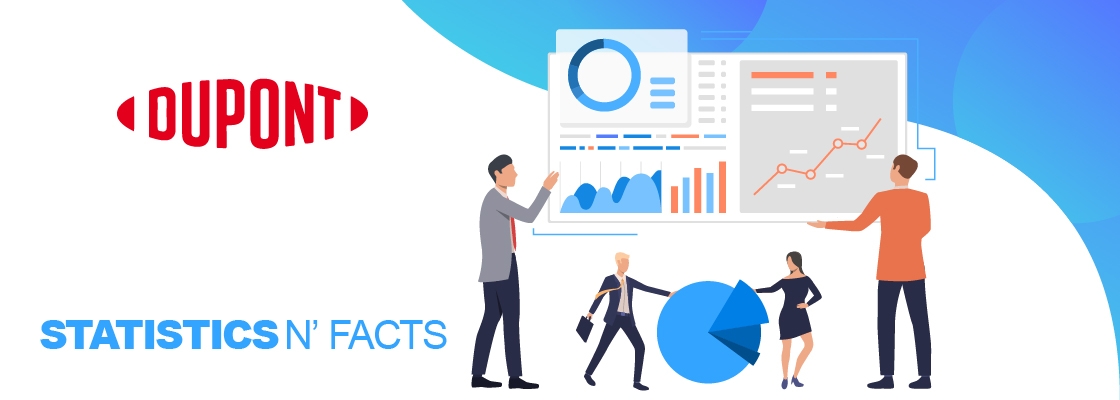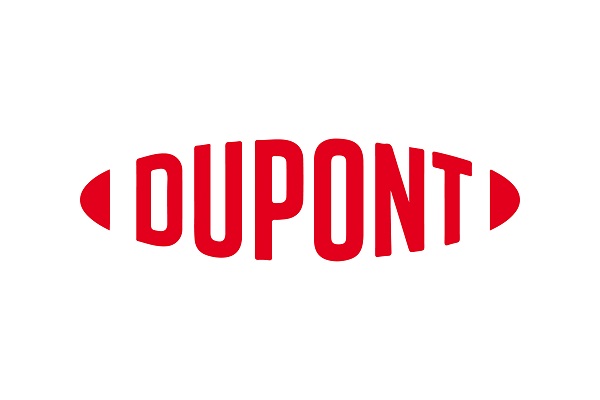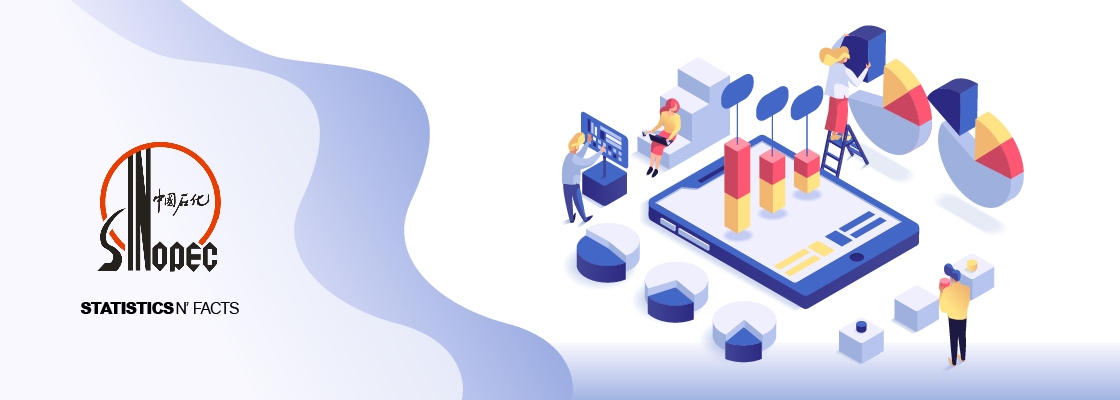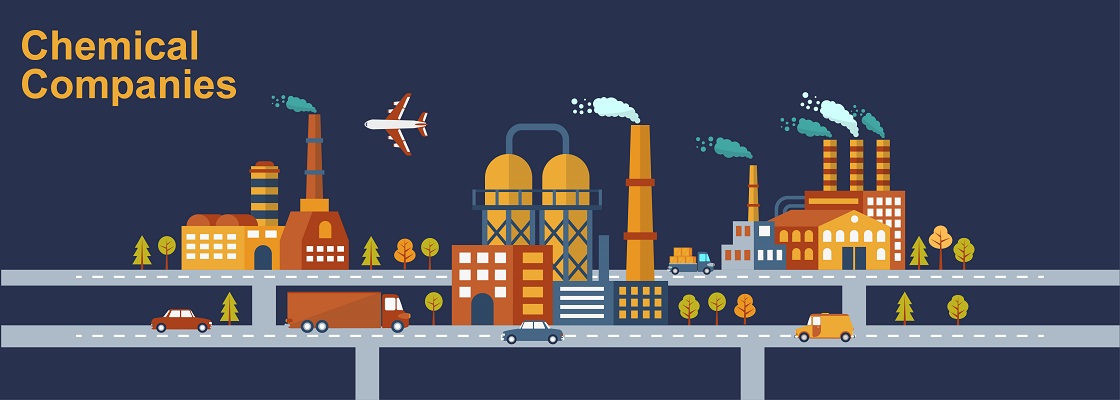DowDuPont Statistics: DowDuPont Inc. is a holding company formed through the merger of The Dow Chemical Company, which is a US-based chemical manufacturing company, and E. I. du Pont de Nemours and Company. DowDuPont is a Delaware corporation formed in December 2015, for the purpose of effecting an all-stock merger of equal transactions between The Dow Chemical Company and E. I. du Pont de Nemours and Company. Both companies merged with subsidiaries of DowDuPont, and as a result, became subsidiaries of DowDuPont as amended in March 2017.
The company’s operations are managed and reported in three business segments namely: agriculture, materials science, and specialty products. The agriculture segment is further sub-segmented into seed and crop protection businesses to deliver a broad portfolio of products and services. The segment leverages the company’s technology, customer relationships, and industry knowledge to improve the quality, quantity, and safety of the global food supply and the global agriculture industry.
The materials science segment is further sub-segmented into performance materials & coatings, industrial intermediates & infrastructure, and packaging & specialty plastics. Through the performance materials & coatings segment, the company manufactures and sells architectural paints and coatings, and industrial coatings, standalone silicones, performance monomers, and silicones, and offers home and personal care solutions. Through the industrial intermediates & infrastructure segment, the company produces and markets ethylene oxides, propylene oxide derivatives, cellulose ethers, redispersible latex powders, acrylic emulsions, and sustainable solutions, etc. Through its packaging & specialty plastics segment, it offers a broad range of existing product lines and has a rich product pipeline that creates competitive advantages for the entire packaging value chain. It also offers polyolefin elastomers and ethylene propylene diene monomer rubbers for automotive, consumer, wire and cable, and construction markets.
Its specialty products segment is further sub-segmented into electronics & imaging, nutrition & biosciences, transportation & advanced polymers, and safety & construction. Through its electronics & imaging segment, DowDuPont Inc. offers key materials for manufacturing of a broad range of consumer electronics, photovoltaic and solar cells, and others. Through the nutrition & biosciences segment, it offers solutions for the global food and beverage, dietary supplements, pharma, home and personal care, energy, and animal nutrition markets. Through its transportation & advanced polymers segment, the company offers engineering resins, adhesives, lubricants, and parts for various applications in transportation, electronics, healthcare, industrial, and consumer end markets. Through its safety & construction segment, DowDuPont Inc. offers engineered products and integrated systems for construction, worker safety, oil and gas, energy, medical device, water purification, and transportation industries.
In 2018, the company’s revenue was around US$ 86 Bn, with the majority of revenue coming from its materials science segment at US$ 48.8 Bn. The specialty products segment accounted for US$ 22.6 Bn, and the agriculture segment for US$ 1.3 Bn the same year.
History:
Du Pont de Nemours and Company (DuPont)
- 1802: The company was established by Éleuthère Irénée du Pont, using gunpowder machinery imported from France
- 1912: The company purchased several smaller chemical companies and thus actions generated government scrutiny under the Sherman Antitrust
- 1914: Pierre S. du Pont invested in the automobile industry and purchased stock in General Motors (GM)
- 1943: The company played a major role in the Manhattan Project, designing, building, and operating the Hanford plutonium-producing plant in Hanford, Washington
- 1950: The company agreed to build the Savannah River Plant in South Carolina as part of the effort to create a hydrogen bomb. In addition, DuPont continued its emphasis on new materials, developing Mylar, Orlon, Dacron, and Lycra.
- 1957: Due to DuPont’s influence within GM, further action under the Clayton Antitrust Act forced DuPont to divest its shares of General Motors
- 1960: The company developed Kevlar with heat-resistant property in order to produce bullet-resistant vests that are used by police and military units
- 1981: DuPont acquired US-based Conoco Inc., which is an oil and gas producing company, in order to have a secure source of petroleum feedstock required for manufacturing fiber and plastics products
- 1999: The company sold all of its shares of Conoco Inc. to Phillips Petroleum Company. In addition, the company acquired Pioneer Hi-Bred agricultural seed company.
- 2001: DuPont sold its pharmaceutical business to Bristol Myers Squibb
- 2002: It sold its Clysar(R) business to Bemis Company
- 2004: The company sold its textiles business to Koch Industries, which included some of its best-known brands such as Dacron polyester, Antron nylon, Lycra (Spandex), Thermolite, and Orlon acrylic
- 2013: DuPont was ranked 86th on the Fortune 500 list. In addition, the company sold its performance coatings to Carlyle Group and rebranded as Axalta Coating Systems.
- 2014: The company was ranked 171st on its Global 2000 by Forbes
- 2015: The company sold its neoprene chloroprene rubber business to Denka Performance Elastomers, which is a joint venture of Denka and Mitsui. Additionally, DuPont completed the separation of its Performance Chemicals business through the spin-off of The Chemours Company.
- 2017: The company merged with the Dow Chemical Company and was known as DowDuPont, Inc.
The Dow Chemical Company:
- 1897: The company was established by H.H. Dow, and was an industry pioneer
- 1898: DuPont began its first commercial-scale production of bleach
- 1900: The company acquired Midland Chemical Company
- 1908: The agricultural chemicals division was established based on a spray for fruit trees
- 1916: Dow first marketed calcium chloride, magnesium metal, and acetylsalicylic acid
- 1918: The company adopted its diamond trademark
- 1921: Pistons made with Dowmetal magnesium were used in the winning Indianapolis 500 car
- 1928: Styrene and Saran were developed
- 1935: Dow entered the plastics business with the introduction of ETHOCEL ethylcellulose resins
- 1937: STYRON polystyrene resin was introduced. In addition, the company was listed on the New York Stock Exchange
- 1943: Dow and Corning Glass formed Dow Corning, which is a joint venture to produce silicone products
- 1947: Dow established Brazos Oil & Gas Co., which is a subsidiary that produced oil and gas for Dow’s needs and constructed pipelines to carry fuel and feedstock to plants
- 1952: Dow established Asahi-Dow, Ltd. in Japan, which is its first subsidiary outside North America
- 1953: Dow introduced Saran Wrap for household purposes
- 1959: Dow Corning Corporation implemented technology to manufacture hyperpure polycrystalline silicon to produce materials for computer chips, and the first fully integrated polycrystalline silicon plant was established in Hemlock, Michigan
- 1961: Dow purchased a manufacturing site in Terneuzen, The Netherlands
- 1964: Handi-Wrap plastic film wrap was introduced
- 1965: Dow’s one-shot measles vaccine was introduced
- 1966: Dow added epoxy resins to its product mix
- 1968: Ziploc bags were test-marketed
- 1970: Dow introduced an automotive product line
- 1972: Dow launched the Lorsban insecticide
- 1973: Dow became the first foreign industrial company to be listed on the Tokyo Stock Exchange
- 1975: Dow supplied STYROFOAM brand insulation for the Alaskan Pipeline
- 1986: Dow ranked as the world’s largest producer of thermoplastics
- 1989: Dow and Eli Lilly formed DowElanco, which is a joint venture to produce agricultural products. Dow acquired pharmaceutical maker Marion Laboratories and created a new publicly traded company, Marion Merrell Dow Inc.
- 1992: Dow’s INSITE constrained geometry catalyst technology was introduced
- 1997: Dow acquired 100% of DowElanco and renamed as Dow AgroSciences
- 2001: Dow acquired Union Carbide
- 2009: Dow acquired Rohm and Haas, which is a key element in Dow’s new Advanced Materials division
- 2010: Dow became a Worldwide Olympic Partner and the Official Chemistry Company for the Olympic Movement through 2020. Additionally, the company completed the divestiture of its Polycarbonate, Latex, Rubber, and Styrenics businesses into an independent company named Trinseo (formerly Styron).
- 2011: Dow unveiled a plan to increase its ethylene and propylene production and connect its US Gulf Coast operations to shale gas liquids. In addition, Dow and Saudi Aramco announced a joint venture to create Sadara Chemical Co.
- 2016: Dow completed a strategic ownership restructuring of Dow Corning and became 100% owner of Dow Corning’s silicones business
- 2017: The company merged with E. I. du Pont de Nemours and Company (DuPont) and was known as DowDuPont, Inc.
Recent Developments:
- In August 2018, DowDuPont specialty products division opened a new manufacturing facility in Burley, Idaho, in order to produce STYROFOAM Brand XPS Insulation products with BLUEDGE Polymeric Flame Retardant Technology
- In May 2018, The Dow Chemical Company – a subsidiary of DowDuPont Inc. – opened its new sales center in Toronto for advanced innovation and customer growth in Eastern Canada
- In September 2017, DowDuPont Materials Science, which is the business division of DowDuPont Inc., announced the startup of its new integrated world-scale ethylene production facility and its new ELITE enhanced polyethylene production facility, both in Freeport, Texas, US
The Business Separations:
- In early 2018, DowDuPont planned to separate into three independent publicly traded companies – one for each of its agriculture, materials science, and specialty products businesses
- The company formed two wholly owned subsidiaries: Dow Holdings Inc. and Corteva, Inc.
- Dow Holdings Inc. serves as a holding company for its materials science business; whereas Corteva, Inc. serves its agriculture business
- In April 2019, DowDuPont completed the separation of its materials science division through the spin-off of Dow Holdings Inc.
- In June 2019, DowDuPont completed the separation of its agriculture division through the spin-off of Corteva, Inc.
- DowDuPont holds the specialty products division as an independent and publicly traded company and renamed DuPont de Nemours, Inc. (DuPont)









